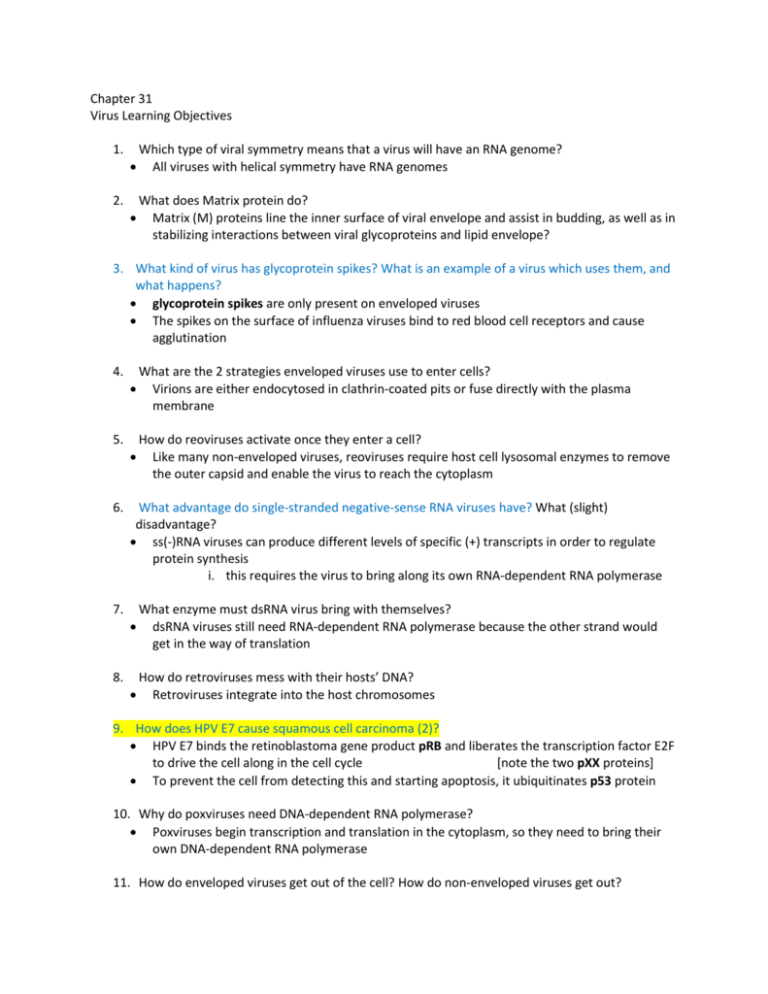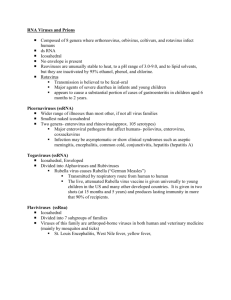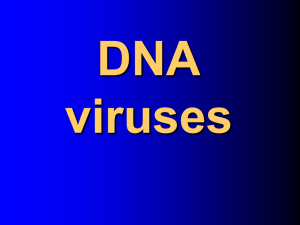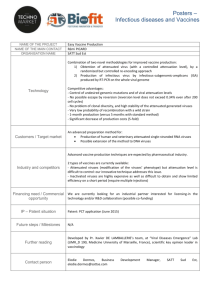microbio 31 [4-20
advertisement

Chapter 31 Virus Learning Objectives 1. Which type of viral symmetry means that a virus will have an RNA genome? All viruses with helical symmetry have RNA genomes 2. What does Matrix protein do? Matrix (M) proteins line the inner surface of viral envelope and assist in budding, as well as in stabilizing interactions between viral glycoproteins and lipid envelope? 3. What kind of virus has glycoprotein spikes? What is an example of a virus which uses them, and what happens? glycoprotein spikes are only present on enveloped viruses The spikes on the surface of influenza viruses bind to red blood cell receptors and cause agglutination 4. What are the 2 strategies enveloped viruses use to enter cells? Virions are either endocytosed in clathrin-coated pits or fuse directly with the plasma membrane 5. 6. What advantage do single-stranded negative-sense RNA viruses have? What (slight) disadvantage? ss(-)RNA viruses can produce different levels of specific (+) transcripts in order to regulate protein synthesis i. this requires the virus to bring along its own RNA-dependent RNA polymerase 7. 8. How do reoviruses activate once they enter a cell? Like many non-enveloped viruses, reoviruses require host cell lysosomal enzymes to remove the outer capsid and enable the virus to reach the cytoplasm What enzyme must dsRNA virus bring with themselves? dsRNA viruses still need RNA-dependent RNA polymerase because the other strand would get in the way of translation How do retroviruses mess with their hosts’ DNA? Retroviruses integrate into the host chromosomes 9. How does HPV E7 cause squamous cell carcinoma (2)? HPV E7 binds the retinoblastoma gene product pRB and liberates the transcription factor E2F to drive the cell along in the cell cycle [note the two pXX proteins] To prevent the cell from detecting this and starting apoptosis, it ubiquitinates p53 protein 10. Why do poxviruses need DNA-dependent RNA polymerase? Poxviruses begin transcription and translation in the cytoplasm, so they need to bring their own DNA-dependent RNA polymerase 11. How do enveloped viruses get out of the cell? How do non-enveloped viruses get out? Enveloped viruses bud from cells, and might not even cause its death i. M proteins usually help Cell lysis 12. How does togavirus (Rubella, equine encephalitis, Semliki forest) budding differ from normal? Togaviruses use glycoproteins to bud rather than M proteins 13. Name the route of transmission: Adenovirus Poliovirus Rotavirus VZV Rhinovirus Cytomegalovirus La Crosse virus airborne large droplet fecal-oral fecal-oral airborne large droplet, contact with lesions physical contact with secretions; NOT airborne blood and body fluid insect bites 14. What type of cells do many enteric viruses use to breach the gut’s mucosal barrier? Microfold (M) cells are the gateway into Peyer patches for enteric viruses 15. Where does primary replication of respiratory viruses occur? Primary replication for respiratory viruses occurs in epithelial or alveolar cells 16. What part of the nervous system lies in direct contact with the environment? The rod processes of olfactory cells are exposed 17. Which viral infections are more serious in adults? EBV, poliovirus, and exanthematous illnesses (VZV) are more severe in older people 18. What form/stage of viral infection causes periodic infectivity? Latent infection causes periodic shedding of the virus 19. What is a serotype? A serotype encompasses all the viruses that are neutralized by the same antibody 20. What parts of the immune system are important for fighting viruses (4)? Cell-mediated immunity, because it can identify both surface and core virus epitopes via MHC Antibody-dependent cell-mediated cytotoxicity (ADCC) Interferons Humoral-mediated immunity prevents reinfection 21. How do interferons fight viruses? induce PKR (protein kinase) and RNase L (endonuclease) [sounds like “nasal pucker”] i. 2,5-oligoisoadenylate synthetase activates RNase L Also activate leukocytes 22. How does CMV avoid destruction by NK cells? How do HSV and some poxviruses evade the immune response? prevents NK cell recognition of MHC deficient cells by producing a dummy MHC protein interfere with complement 23. During culturing of cells for viruses, what does the presence of syncytia suggest? How about cytomegally? Hemadsorption? HSV, RSV, measles, and mumps produce syncytia [SYNCerely He SerVes, ReSerVes, MUMbleS and MEeps] HSV, CMV, and VZV cause cytomegaly [all the --Vs except for HIV and hepatitis] Orthomyxoviruses and paramyxoviruses cause hemadsorption 24. Which viruses are diagnosed using a combination of PCR and (?) Southern blot HIV, hepatitis C, parvovirus, and HSV are all detected using PCR







